Kei truck
A kei truck, kei-class truck, or Japanese mini truck is a mini truck, a type of pickup truck available in rear-wheel drive or four-wheel drive versions, built to satisfy the Japanese keijidōsha (軽自動車, "light vehicle") statutory class. They are known as keitora (軽トラ, "light truck") in Japan alongside the microvan.
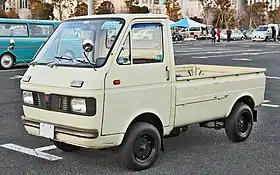
Design
The kei truck class specifies a maximum size and displacement, greatly increased since legislation first enabled the type in 1949. They evolved from earlier three-wheeled trucks based on motorcycles with a small load-carrying area, called san-rin (三輪), which were popular in Japan before the war. The 1998 law admits a maximum length of 3.4 m (134 in), a maximum width of 1.48 m (58 in) and a maximum height of 2.0 m (79 in) with a maximum displacement of 660 cc (cm3). They weigh about 700 kg (1,500 lb), and when ungoverned, can reach up to 120 km/h (75 mph). Due to the limits established with regards to vehicle length, most, if not all, current trucks in this classification are built with the "cab over" approach to maximize load-carrying abilities - the Suzuki Mighty Boy is one of the rare historical exceptions. Despite the size and engine displacement, most kei trucks have a bed load capacity of nearly 350 kg (770 lb). For export markets, kei trucks are usually fitted with bigger engines to allow them even more carrying capabilities. An Indonesian version of the originally 543-cc Suzuki Carry was built with a 1.6-L unit – nearly three times larger.
Typical manufacturers and model names include: Daihatsu Hijet, Subaru Sambar, Suzuki Carry, Mazda / Autozam Scrum, Mitsubishi Minicab. Honda has ended production and sales of kei trucks with the end of production of Honda Acty in 2021. The first kei truck to go on sale was the Kurogane Baby, manufactured from 1959 until 1962.
Many of these have been produced under license abroad, such as the Piaggio Porter. In South Korea, Daewoo and Asia (Kia) produced rebadged Suzuki Carry/Every, and Daihatsu Hijet vans as Daewoo Labo/Damas, and the Asia/Kia Towner.
Gallery
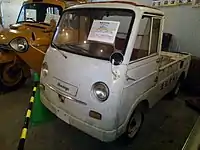 The Kurogane Baby was the first kei truck and an early adopter of the cab-over design
The Kurogane Baby was the first kei truck and an early adopter of the cab-over design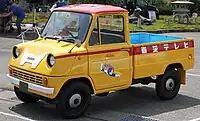 The bonneted Honda T360 was Honda's first automobile
The bonneted Honda T360 was Honda's first automobile The Suzuki Carry L40 was designed by Giorgetto Giugiaro
The Suzuki Carry L40 was designed by Giorgetto Giugiaro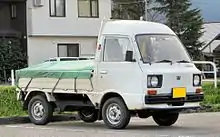 The Subaru Sambar was one of the first kei trucks, here a 1980s model
The Subaru Sambar was one of the first kei trucks, here a 1980s model.jpg.webp) The Mitsubishi Minicab (1991-1999 model)
The Mitsubishi Minicab (1991-1999 model)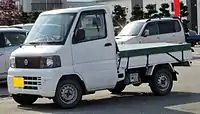 The Nissan Clipper was initially based on Mitsubishi's Minicab, but both of these are re-badged Suzuki Carrys since 2012
The Nissan Clipper was initially based on Mitsubishi's Minicab, but both of these are re-badged Suzuki Carrys since 2012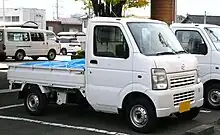 The Mazda Scrum has always been a rebadged Suzuki Carry
The Mazda Scrum has always been a rebadged Suzuki Carry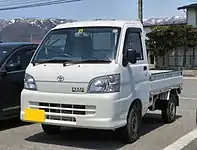 The current Toyota Pixis, a rebadged Daihatsu Hijet
The current Toyota Pixis, a rebadged Daihatsu Hijet
Uses
Widely employed throughout Asia in agriculture, fisheries, construction, and even for firefighting,[1] used models originally appeared in the US for off-road use typically by farmers and hunters. Japanese laws encourage declaring vehicles surplus after a relatively short life; consequently, used kei trucks are often imported into America for sale. Due to the progressive tax on used vehicles in Japan, many of the trucks arrive in excellent condition with very low mileage.[2] They are built with a strong, full, box-frame design with fully enclosed cabs, seat belts, windshield wipers, AM radios, heaters, lights and signals, and catalytic converters, and are claimed to run 64 km (40 mi) on 1 US gal (3.8 L; 0.83 imp gal) of gasoline. They generally have 1.8 m (6 ft) pickup beds with fold-down sides; dump and scissor-lift beds are also available, as are van bodies. The length limitation forces all of these models into a cab-forward design.
While street legal in Japan, kei trucks do generally have the standard equipment required for US roadways such as seat belts, approved lighting (headlamps, tail lights, reverse and brake lights, turn signals), horn and US standard "AS1/AS2" safety glass; they must pass state safety inspections where required. They are approved for use on local roads in several states, while other states do not have any special legislation regarding them. Some controversy has arisen regarding their use on US roadways, largely caused by an outdated report by the nonlegislative American Association of Motor Vehicle Administrators. The report, issued in 2011, raised concerns about the safety and emissions compliance of kei trucks. At the time of the report, available data were limited regarding the vehicles, but the concerns have largely been dismissed, as jurisdictions have become more knowledgeable. Since 2010, many common uses in the US include campus maintenance vehicles, landscape and property maintenance, delivery vehicles, agricultural uses, golf courses, construction sites, small-business transportation and advertisement, and private recreational and homeowner use. Fire departments, ambulance companies, and even some police agencies have incorporated kei trucks in to their fleets due to the extreme versatility, durability, and low cost compared to other utility type vehicles. State legislation passed during 2008 in Oklahoma and Louisiana are the most liberal, prohibiting their use only on interstate highways.[3] Kei vehicles older than 25 years may be imported into the US with very few restrictions.[4][5]
In the Philippines, many kei trucks and vans have found a second life as a form of public transportation called "multicabs". These are used Japanese-market kei vehicles, refurbished to meet local requirements by various companies such as Norkis Motors.
See also
References
- "The Littlest Kei Fire Truck – World's Smallest?". Integrity Exports. 28 March 2012. Retrieved 15 December 2012.
- Nakashima, Ken (15 December 2020). "Kei Cars – Everything You Need To Know". JDM Export.
- "Mini-truck state laws". US: Insurance Institute for Highway Safety. December 2012. Archived from the original on 24 September 2010. Retrieved 15 December 2012.
- "Importation and Certification FAQ's Directory—All Vehicles". NHTSA.gov. US: National Highway Traffic Safety Administration. Retrieved 1 May 2016.
- "Rural Americans are importing tiny Japanese pickup truck". The Economist. 20 April 2023.